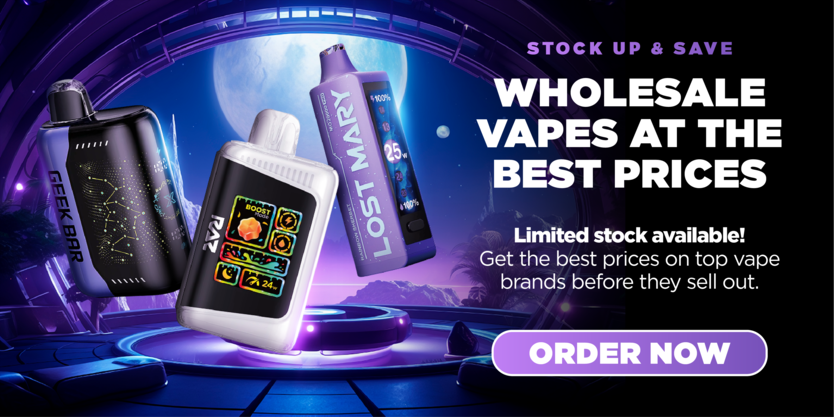How Are Vapes Made? A Brief History of Vaping
Estimated 0 min read
Vaping has become a global phenomenon, reshaping how people consume nicotine and other substances. But have you ever wondered how vapes were invented and how they are made today? From the earliest patents to the latest technology trends in 2025, this article dives into the fascinating history and modern manufacturing of vapes to give retailers and curious readers a full picture.
Table of Contents:
The First Vape Patents: A Spark of Innovation
Believe it or not, the story of vaping dates back nearly a century. In 1930, Joseph Robinson filed the first patent for an “electronic vaporizer” designed to deliver medicinal compounds through inhalation. Although the device was never manufactured, this early concept laid the foundation for future inventors.
In 1963, Herbert Gilbert patented a "smokeless non-tobacco cigarette," aiming to replace traditional cigarettes. His design included a battery-powered heating element and proposed using propylene glycol, a key ingredient still used in vape juice today. Like Robinson’s invention, Gilbert’s patent remained unproduced but was crucial to vaping’s evolution.
The Favor Cigarette and Early Nicotine Delivery
Long before electronic vapes, the Favor Cigarette tried to revolutionize nicotine delivery with a liquid nicotine paper cigarette, invented by computer pioneer Phil Ray and his physician friend Norman Jacobson. They coined the term “vape”, which has stuck ever since.
Despite their innovation, the Favor Cigarette faced challenges with nicotine stability — the liquid nicotine turned bitter over time, limiting commercial success. Yet, their work significantly influenced how nicotine could be delivered in safer, smoke-free ways.
How FDA Regulations Shaped Vape Development
Fast forward to the 1990s and early 2000s: many inventors attempted to create electronic nicotine delivery systems. In 1998, a major tobacco company sought FDA approval for an electronic cigarette-like device. However, the FDA classified it as an unapproved drug delivery system and denied the request.
This regulatory stance slowed innovation in the US market for years, while companies elsewhere continued development, setting the stage for the next big breakthrough.
Hon Lik’s Dream: The Modern Vape Revolution
The breakthrough came in 2003 thanks to Hon Lik, a Chinese pharmacist driven by the loss of his father to smoking-related illness. Inspired by a dream where drowning waters evaporated, he invented the first commercially successful electronic cigarette.
Hon Lik’s device used a battery-powered coil to vaporize nicotine solution without combustion. His employer, Ruyan (“like smoke”), manufactured and launched the device internationally by 2006, sparking the vape boom that continues today.
How Are Vapes Made Today? Key Components Explained
Today’s vaping devices vary widely, from sleek pod systems and powerful box mods to convenient disposables. Despite differences, all vapes share three essential components:
-
Power Source: Usually a rechargeable lithium-ion battery that supplies energy.
-
Heating Coil: A metal coil that heats up to vaporize the liquid.
-
Vape Juice: A liquid mixture typically containing nicotine, propylene glycol, vegetable glycerin, and flavorings.
Manufacturing Process:
Vape makers assemble these components carefully to ensure safety, reliability, and great performance. The battery powers the coil, which heats the cotton wick soaked in vape juice. This heats the liquid into vapor, which users inhale.
The rectangular shape common in many vapes helps house the battery efficiently, although innovations in design are constantly emerging.
Emerging Trends in Vape Manufacturing (2025 Update)
As the vape industry evolves, manufacturers are innovating to meet new consumer demands and regulations:
-
Smart Vape Devices: Integrated Bluetooth and app connectivity let users customize settings, monitor usage, and receive firmware updates.
-
Sustainable Materials: More brands are adopting eco-friendly materials and rechargeable systems to reduce waste.
-
Nicotine Salt Formulations: These enable smoother hits at higher nicotine strengths, popular among new vapers.
-
Regulatory Compliance: Stricter global standards drive manufacturers to improve quality control and safety testing.
-
Expanded Flavor Innovations: Growing demand for exotic and natural flavor profiles pushes R&D into new vape juice blends.
Conclusion: Staying Ahead in the Vape Market
Understanding the history and manufacturing process of vapes can help retailers and vape enthusiasts appreciate this dynamic industry. From early patents and FDA hurdles to today’s smart devices and sustainable trends, vaping continues to evolve rapidly.
At VapeRanger, we offer a vast selection of high-quality vape products from trusted brands worldwide. Whether you’re stocking a vape shop or expanding your product line, our reliable wholesale service with international shipping has you covered.
Explore our catalog today and see why VapeRanger is the go-to vape wholesaler for 2025!









